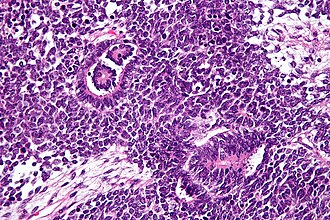Difference between revisions of "Wilms tumour"
Jump to navigation
Jump to search
| Line 1: | Line 1: | ||
{{ Infobox diagnosis | |||
| Name = {{PAGENAME}} | |||
| Image = Wilms_tumour_-_very_high_mag.jpg | |||
| Width = | |||
| Caption = Wilms tumour. [[H&E stain]]. | |||
| Synonyms = nephroblastoma | |||
| Micro = | |||
| Subtypes = | |||
| LMDDx = | |||
| Stains = | |||
| IHC = WT-1 +ve | |||
| EM = | |||
| Molecular = | |||
| IF = | |||
| Gross = | |||
| Grossing = | |||
| Site = [[kidney]] - see ''[[pediatric kidney tumours]]'' | |||
| Assdx = | |||
| Syndromes = WAGR syndrome, [[Beckwith-Wiedemann syndrome]], [[Denys-Drash syndrome]] | |||
| Clinicalhx = | |||
| Signs = abdominal mass | |||
| Symptoms = | |||
| Prevalence = most common pediatric kidney tumour | |||
| Bloodwork = | |||
| Rads = | |||
| Endoscopy = | |||
| Prognosis = | |||
| Other = | |||
| ClinDDx = | |||
| Tx = | |||
}} | |||
'''Wilms tumour''', also '''nephroblastoma''' and '''Wilms' tumour''', is the most common [[Pediatric_kidney_tumours|pediatric kidney tumour]].<ref name=pmid10935424>{{cite journal |author=Coppes MJ, Wolff JE, Ritchey ML |title=Wilms tumour: diagnosis and treatment |journal=Paediatr Drugs |volume=1 |issue=4 |pages=251–62 |year=1999 |pmid=10935424 |doi= |url=}}</ref><ref name=pmid15738594>{{cite journal |author=Stefanowicz J, Sierota D, Balcerska A, Stoba C |title=[Wilms' tumour of unfavorable histology--results of treatment with the SIOP 93-01 protocol at the Gdańsk centre. Preliminary report] |language=Polish |journal=Med Wieku Rozwoj |volume=8 |issue=2 Pt 1 |pages=197–200 |year=2004 |pmid=15738594 |doi= |url=}}</ref> | '''Wilms tumour''', also '''nephroblastoma''' and '''Wilms' tumour''', is the most common [[Pediatric_kidney_tumours|pediatric kidney tumour]].<ref name=pmid10935424>{{cite journal |author=Coppes MJ, Wolff JE, Ritchey ML |title=Wilms tumour: diagnosis and treatment |journal=Paediatr Drugs |volume=1 |issue=4 |pages=251–62 |year=1999 |pmid=10935424 |doi= |url=}}</ref><ref name=pmid15738594>{{cite journal |author=Stefanowicz J, Sierota D, Balcerska A, Stoba C |title=[Wilms' tumour of unfavorable histology--results of treatment with the SIOP 93-01 protocol at the Gdańsk centre. Preliminary report] |language=Polish |journal=Med Wieku Rozwoj |volume=8 |issue=2 Pt 1 |pages=197–200 |year=2004 |pmid=15738594 |doi= |url=}}</ref> | ||
Revision as of 01:44, 6 May 2014
| Wilms tumour | |
|---|---|
| Diagnosis in short | |
 Wilms tumour. H&E stain. | |
|
| |
| Synonyms | nephroblastoma |
| IHC | WT-1 +ve |
| Site | kidney - see pediatric kidney tumours |
|
| |
| Syndromes | WAGR syndrome, Beckwith-Wiedemann syndrome, Denys-Drash syndrome |
|
| |
| Signs | abdominal mass |
| Prevalence | most common pediatric kidney tumour |
Wilms tumour, also nephroblastoma and Wilms' tumour, is the most common pediatric kidney tumour.[1][2]
General
- Common abdominal pediatric tumour.
- May be associated with a syndrome:[3]
- WAGR syndrome (Wilms tumour, Aniridia (absence of iris), GU abnormalities, Retardation).[4]
- Beckwith-Wiedemann syndrome.[5]
- Denys-Drash syndrome.[6]
Gross
- Lobulated tan mass.
Image: Wilms tumour (med.utah.edu).
Microscopic
Features - classically three components (blastema, immature stroma, tubules):[7]
- Malignant small round blue cells ("blastema"):
- Size = ~ 2x RBC diameter.
- Nuclear pleomorphism (variation of size, shape and staining).
- Irregular nuclear membrane - important.
- Scant/difficult to discern cytoplasm - basophilic (light blue).
- Mitoses - common.
- Stroma ("immature stroma"):
- Spindle cells:
- Elliptical nuclear membrane.
- Abundant loose cytoplasm.
- Spindle cells:
- Tubular structures ("tubules"):
- Usually clustered.
- Vaguely resemble a glomerulus.
- Usu. have a central (clear/white) space surrounded by a rim of intensely eosinophilic cytoplasm.
- Nuclei of tubular structures often elongated and palisaded.
Other findings:
- Commonly seen in association with nephrogenic rests.
- Cluster of cells small (blue) cells; lack nuclear atypia seen in Wilms tumour.[8]
- +/-Heterologous elements (skeletal muscle, smooth muscle adipose tissue, cartilage).[9]
- Heterologous = doesn't normally belong there.[10]
DDx:
- Metanephric adenoma.
- Nephrogenic nests.
- Other small round cell tumours.
- Synovial sarcoma, biphasic - especially in adults.
Notes:
- Palisade = fence made of stakes driven into the ground.[11]
- Approximately 30-40% Wilms tumour cases have nephrogenic rests.[12]
- The three phases are also called blastemal, epithelial and stromal.[9]
Images
www:
Anaplasia
Subclassified as:[9]
- Focal anaplasia.
- Diffuse anaplasia.
Criteria (all of the following):[9]
- Atypical mitoses.
- Nuclear hyperchromasia.
- Nuclear size variation (of the tumour cells) > 3x.
IHC
- WT-1 +ve.
See also
References
- ↑ Coppes MJ, Wolff JE, Ritchey ML (1999). "Wilms tumour: diagnosis and treatment". Paediatr Drugs 1 (4): 251–62. PMID 10935424.
- ↑ Stefanowicz J, Sierota D, Balcerska A, Stoba C (2004). "[Wilms' tumour of unfavorable histology--results of treatment with the SIOP 93-01 protocol at the Gdańsk centre. Preliminary report]" (in Polish). Med Wieku Rozwoj 8 (2 Pt 1): 197–200. PMID 15738594.
- ↑ URL: http://emedicine.medscape.com/article/989398-overview. Accessed on: 9 March 2011.
- ↑ Online 'Mendelian Inheritance in Man' (OMIM) 194072
- ↑ Online 'Mendelian Inheritance in Man' (OMIM) 130650
- ↑ Online 'Mendelian Inheritance in Man' (OMIM) 194080
- ↑ Mitchell, Richard; Kumar, Vinay; Fausto, Nelson; Abbas, Abul K.; Aster, Jon (2011). Pocket Companion to Robbins & Cotran Pathologic Basis of Disease (8th ed.). Elsevier Saunders. pp. 254-5. ISBN 978-1416054542.
- ↑ URL: http://www.pathconsultddx.com/pathCon/diagnosis?pii=S1559-8675%2806%2970416-8. Accessed on: 28 March 2011.
- ↑ 9.0 9.1 9.2 9.3 Humphrey, Peter A; Dehner, Louis P; Pfeifer, John D (2008). The Washington Manual of Surgical Pathology (1st ed.). Lippincott Williams & Wilkins. pp. 282. ISBN 978-0781765275.
- ↑ URL: http://www.biology-online.org/dictionary/Heterologous. Accessed on: 1 October 2011.
- ↑ URL: http://www.thefreedictionary.com/palisaded. Accessed on: 2 February 2011.
- ↑ Coppes MJ, Haber DA, Grundy PE (September 1994). "Genetic events in the development of Wilms' tumor". N. Engl. J. Med. 331 (9): 586–90. doi:10.1056/NEJM199409013310906. PMID 8047084.



